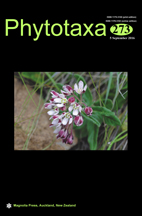Abstract
Iris aphylla Linnaeus (1753: 38) (Iridaceae) is a highly variable species from the morphological point of view, especially in the height of stem, stem branching, size of leaves, and color of flowers. Moreover, it can be found in different habitats. In the Middle-Russian Upland, this plant is mostly associated with meadow steppes on slopes and, rarely, with edges of shrub thickets; also occurs along forest edges and in open forests, where blooming plants are rare (Kazakova et al. 2015). It is native to Central, Eastern, and some parts of Western Europe. The species is widespread in the Ukraine and mainly in the south of middle European Russia, while in the European countries its populations are sparser. Iris aphylla is of autotetraploid origin (Mitra 1956); plants with the chromosome number 2n = 48 are found more frequently in Europe (Wróblewska et al. 2010). Its numerous synonyms, including four subspecies, indicate the variability of this species. The genetic data confirm the conclusion that the subspecies of I. aphylla should be regarded as a single species (Wróblewska et al. 2010). According to my best knowledge (see also Jarvis 2007) the name I. aphylla is still lacking typification.

